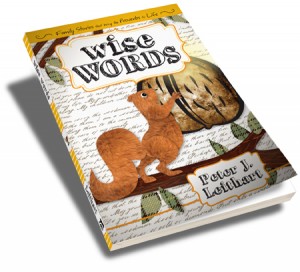 On another recent road trip the family and I listened to the audio book for Peter Leithart’s delightful book, Wise Words: Family Stories That Bring the Proverbs to Life (Canon Press).
On another recent road trip the family and I listened to the audio book for Peter Leithart’s delightful book, Wise Words: Family Stories That Bring the Proverbs to Life (Canon Press).
Here is the publisher’s description:
Following the tradition of Grimm’s fairy tales, these bedtime stories wander down stardusted paths, gallop to mountaintop castles, and tread through dragons’ lairs. At the same time, these eighteen adventures echo and illustrate the lessons of Proverbs in a manner sure to delight readers of all ages, especially those in their jammies.
Each of the 18 imaginative stories ends with a “moral,” which is one of the Proverbs. Every story kept our kids’ attention.
In the preface Leithart writes that his intention in Wise Words was to write stories
that would appeal to children as stories;
that would challenge parents who read to their children;
that would illustrate biblical proverbs;
and that would borrow imagery, plots, characters, settings, and themes from the Bible.
The result are fictional stories that reverberate with the biblical story. To give you an example (posted with permission), below is the audio for one of the longer stories, “King Jacob of the Green Garland,” about 13 minutes in length. The narration is by Rev. Toby Sumpter, a capable though not professional narrator:
[audio:http://blogs.thegospelcoalition.org/justintaylor/files/2010/10/08-King-Jacob-of-the-Green-Garland.mp3|titles=08 King Jacob of the Green Garland](Download the MP3 file.)
In the preface, Leithart explains that there is more going on in this story than might first meet the eye (or ear, as it were):
“King Jacob of the Green Garland” is, at a basic level, a straightforward illustration of its moral. Eric’s throne is insecure because of his injustice and cruelty, while Jacob’s is established by the kindness and love he shows to his subjects.
The plot weaves together threads from a number of Biblical events.
Eric is an Adam, who because of pride loses his throne and must flee from his garden into the wilderness.
Eric is “the Red” because he is like Esau, who despised his birthright and persecuted his righteous brother. Similarly, the real Esau was an Adam who sold his inheritance for food.
After his fall, Eric becomes, like Nebuchadnezzar, a beast in the wilderness.
As Eric dies, he acknowledges his sins, and passes the kingship to his brother Jacob, the faithful heir.
The king dies, but a new king rises to take his place.
Jacob is the type of the Last Adam, who wins the throne, returns to his garden, and gives gifts to men.
Later, he delivers the final blow to his enemy, William the Black, and thereafter rules his kingdom forever.
The green garland crown signifies wisdom and justice (Proverbs 4:9); Jacob has become a tree of life to his people.
The “moral” of the story is Proverbs 20:28: “Love and faithfulness keep a king safe; through love his throne is made secure” (NIV).
I warmly recommend this as a great resource for families.


















